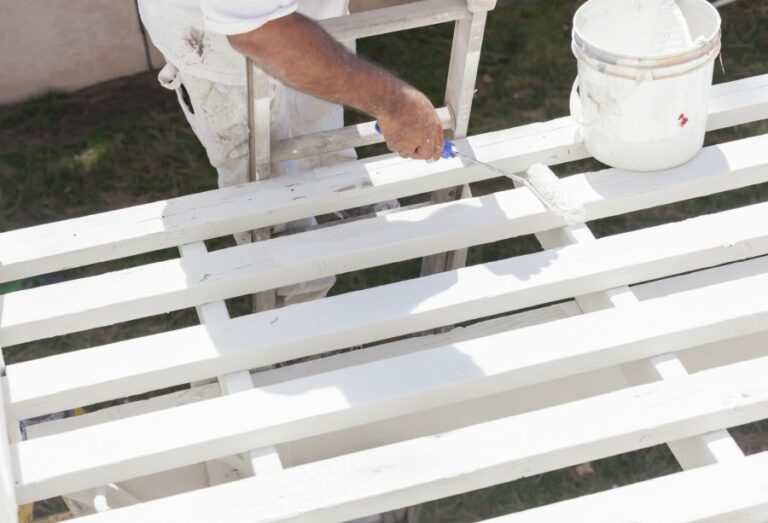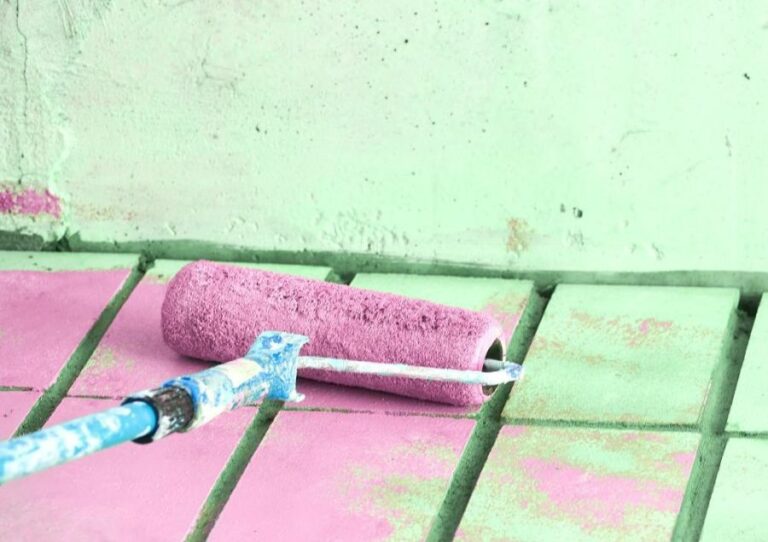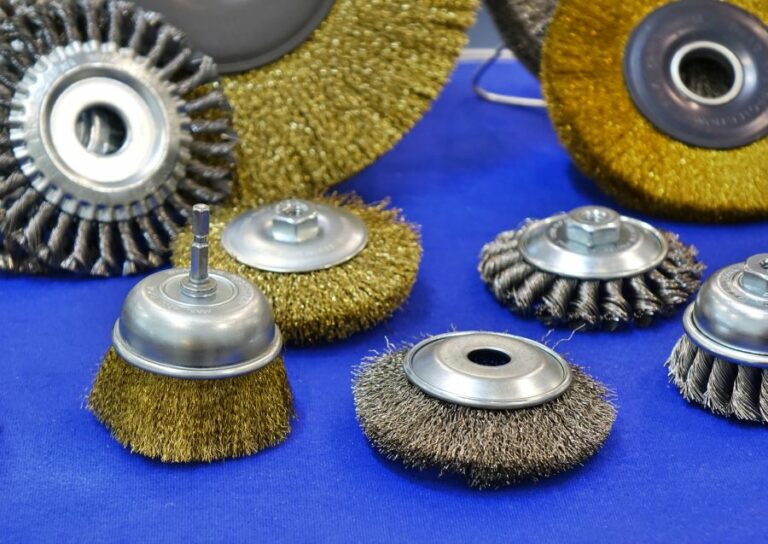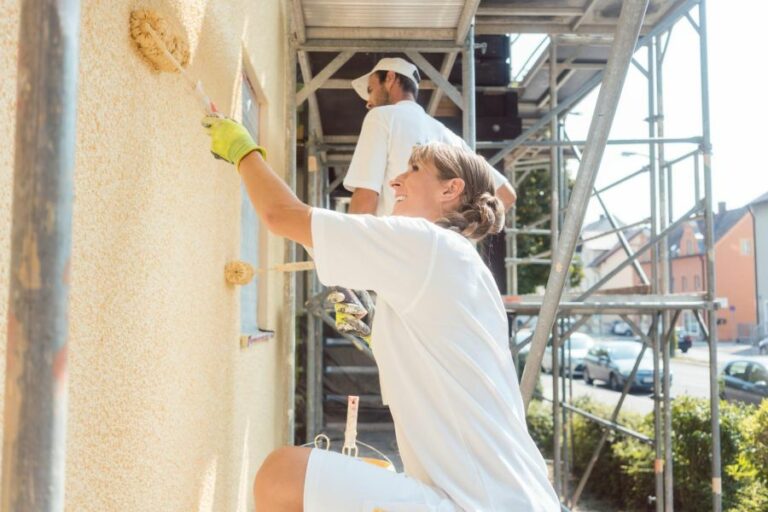Determine Surface Conditions For Prep. What Pros Say
When it comes to preparing surfaces for various projects, knowing the right conditions and steps to follow is crucial for success. Worry no more, as we have you covered! In this discussion, we’ll explore how to determine surface conditions, ensuring proper prep that leads to a flawless final result.
Determine surface conditions for prep:>
To determine surface conditions for preparation, understand the substrate type, inspect for defects and contaminants, choose the appropriate cleaning method, assess the required surface profile, and monitor environmental conditions. These steps promote successful paint or coating application and a high-quality, durable finish.

Discover the crucial steps and techniques to determine surface conditions for the perfect preparation. Unearth the secrets to achieve a flawless outcome for your project. Read on and transform your skills as we dive into this essential aspect.
Contents
- 1 Assessing Surface Conditions for Proper Preparation
- 2 Evaluating Surface Readiness for Preparation
- 3 Key Factors to Consider in Surface Preparation
- 4 Essential Conditions for Successful Surface Coating
- 5 Understanding Surface Preparation Standards
Assessing Surface Conditions for Proper Preparation
Surface preparation is a critical step in the process of painting or coating any structure. Ensuring that the surface is clean, dry, and free from contaminants not only enhances the overall appearance but also increases the durability and lifespan of the paint or coating being applied.
• Understand your Substrate
The first step to determining the correct surface conditions for preparation is to understand the type of substrate on which the paint or coating will be applied. Common substrate materials include:
- Concrete
- Steel
- Wood
- Plaster
- Drywall
- Fiberglass
- Aluminum
Each material has unique characteristics that can impact the surface preparation process, so it’s essential to become familiar with your specific substrate.
• Inspect the Surface for Defects and Contaminants
Before beginning the preparation process, it is crucial to thoroughly inspect the surface for any defects or contaminants that could impede the application or adhesion of the paint or coating. Some common issues include:
– Rust and corrosion
Metal surfaces, particularly steel, and iron, are prone to rust and corrosion. When present, these issues must be addressed to ensure proper adhesion and prevent further damage.
The National Association of Corrosion Engineers (NACE) provides guidelines on handling rust and corrosion during surface preparation.
– Cracks and pits
Cracks, pits, and other surface irregularities are particularly common in concrete and plaster surfaces. In such cases, the affected areas must be repaired and smoothed before continuing.
– Dirt and debris
Regardless of the substrate, any dirt, debris, or loose particles must be cleaned before beginning the project. This can be achieved through sweeping, vacuuming, or air-blowing the surface.
– Grease, oil, and other contaminants
Grease, oil, or other chemical contaminants can prevent paint or coatings from adequately adhering to the surface. To remove such substances, consider using a degreaser or detergent, followed by thorough rinsing and drying.
– Existing paint
In some cases, existing paint may need to be removed before applying a new finish. Pay close attention to any areas of existing paint that are peeling, flaking, or chalking, as these could indicate poor adhesion or degradation of the underlying surface.
• Choose the Right Cleaning Method
Once the surface has been inspected and any deficiencies have been addressed, it is essential to choose the appropriate cleaning method to prepare the surface further. Some common cleaning methods include:
– Abrasive blasting
Abrasive blasting is an efficient method for removing rust, old paint, or other surface contaminants. This technique can be performed with various media types, such as sand, steel shot, or glass beads, and is particularly effective on metal surfaces.
– Power washing
Power washing uses water under high pressure to remove dirt, debris, and contaminants from the surface. This method is suitable for use on various substrates, including concrete, wood, and aluminum.
– Chemical cleaning
In some cases, it may be necessary to use chemical cleaning agents, such as solvents or detergents, to remove contaminants that are resistant to other cleaning methods.
Always follow the manufacturer’s recommendations when using chemical cleaners, and ensure that the surface is thoroughly rinsed and dried after application.
– Hand tools and sanding
For smaller projects or areas requiring more delicate attention, hand tools such as wire brushes and sandpaper can also be effective for cleaning and preparing surfaces.
• Assess and Measure Surface Profile
After cleaning, the next step is to assess the surface profile, the texture or roughness of the surface that can affect the adhesion and performance of the applied coating. The ideal surface profile will depend on the type of coating being applied and the substrate.
Surface profile measurements can be taken using instruments such as a test ex replica tape, a surface profile gauge, or a profilometer. It is essential to consult the coating manufacturer’s guidelines for the recommended surface profile range for the specific product you are using.
• Monitor Environmental Conditions
Lastly, be mindful of the environmental conditions throughout the preparation and application process. Factors such as temperature, humidity, and wind can significantly impact the coating’s performance and adhesion.
In general, it is recommended to avoid applying paint or coatings in extreme temperatures or excessive humidity. Additionally, ensure that the surface is entirely dry before application, and consider using dehumidifiers or heaters if needed to help control environmental conditions.
In conclusion, to determine the appropriate surface conditions for preparation, it is essential to understand your substrate, inspect for defects and contaminants, choose the right cleaning method, assess the required surface profile, and monitor environmental conditions.
Following these steps will help ensure the success of your painting or coating project and contribute to a high-quality, durable finish.
Evaluating Surface Readiness for Preparation
Surface preparation is a crucial step in many industrial processes, from painting and coating applications to adhesive bonding and more. Proper surface preparation ensures that a material’s surface is clean, free of contaminants, and ready for the application of coatings or adhesives.
• Importance of Surface Preparation
Without proper surface preparation, coatings and adhesives may not adhere correctly, leading to poor performance and potentially costly repairs. Surface preparation is necessary to create a strong bond between the applied material and the substrate.
It also helps to ensure the longevity of the finished product, contributing to a more durable and high-quality result.
• Visual Inspection: Your First Line of Defense
The initial step in checking surface preparation is the visual inspection. This simple yet crucial step can provide insight into the cleanliness and overall condition of the surface. When visually inspecting a surface, look for the following:
- Surface defects, such as cracks or dents
- Contaminants or debris, including dust, dirt, or grease
- Previous coatings or residue
- Proper surface profile for the intended application
Visual inspections are straightforward and require no special equipment. However, they may not always provide enough information to ensure the surface is fully prepared, especially for applications requiring a high level of quality or reliability. For a more detailed inspection, other methods are necessary.
• Abrasive Blast Cleaning: An Industry Standard
Abrasive blast cleaning is a widely accepted method for surface preparation, particularly in the protective coatings industry. This process involves the use of compressed air to propel abrasive particles against the substrate quickly.
This action removes surface contaminants, creates the desired surface profile, and enhances the surface’s ability to bond with the applied material.
When checking surface preparation after abrasive blast cleaning, consider the following:
- Surface cleanliness: Look for any remaining contaminants and verify that the surface is free of dust and debris post-blast.
- Surface profile: Measure the profile’s depth using surface profile comparators or replica tape. Ensure the profile meets the specifications required for the intended application.
- Substrate conditions: Check for damage or changes to the substrate, such as discoloration or warping from heat.
For reference on acceptable standards of surface preparation after abrasive blast cleaning, consult resources like the SSPC (Society of Protective Coatings), which provides a comprehensive guide to surface preparation standards.
• Solvent Cleaning: Checking for Cleanliness
Solvent cleaning is another common method for surface preparation, particularly for surfaces subject to oils, grease, or other contaminants that may interfere with adhesion. Like abrasive blast cleaning, solvent cleaning requires thorough verification to ensure adequate surface preparation.
When checking surface preparation after solvent cleaning, carry out the following:
- Solvent residue: Confirm that all solvent has evaporated or been wiped away from the surface.
- Cleanliness level: Inspect the surface for remaining contaminants or signs of insufficient cleaning.
- Compatibility: Ensure the chosen solvent does not damage or react with the substrate material.
• Adhesion Testing: Confirming Proper Preparation
Ultimately, the goal of surface preparation is to promote adhesion between the substrate and the applied material. Adhesion testing is an essential assessment of overall surface preparation quality.
Several testing methods are available to gauge the strength and effectiveness of this bond. Some commonly used adhesion tests include:
- Peel test: A method typically used for adhesive joints, where a tape or other adhesive material is applied to the prepared surface, then peeled away to reveal the adhesive’s ability to bond with the substrate.
- Tensile test: This test measures the force required to separate the applied material from the substrate, providing insight into the bond’s overall strength and quality.
- Cross-cut test: Used to evaluate the adhesion of coatings, this test involves making a cross-hatch pattern on the substrate with a sharp knife, followed by the application of adhesive tape. When the tape is removed, the amount of coating adhering to the tape reveals the strength of the bond.
When selecting an adhesion test, consider the specific application and industry standards to ensure the most accurate and relevant results.
• Final Thoughts on Surface Preparation
Checking surface preparation is a critical aspect of ensuring optimal performance and longevity for many applications. By employing a combination of visual inspection, abrasive blast cleaning, solvent cleaning, and adhesion testing, you can effectively evaluate surface preparation quality.
By doing so, you will promote a strong bond between your substrate and the applied material, resulting in higher-quality, more durable finished products.
Steps | Description |
|---|---|
1. Visual Inspection | Examine the surface for any visible contaminants, dust, or rough spots. |
2. Surface Profile Measurement | Use a surface profile gauge to measure the peak-to-valley height of the surface. |
3. Cleanliness Standards Comparison | Compare the surface to cleanliness standards, such as the SSPC-SP or ISO standards, to ensure the level of preparation is adequate. |
4. Surface Tension Test | Perform a surface tension test, such as a water break test or a dyne test, to check for any contaminants that may be present. |
5. Adhesion Tests | Conduct adhesion tests, such as a pull-off test or a tape test, to ensure that the coating will adhere properly to the surface. |
6. Surface Temperature and Humidity Measurement | Measure the surface temperature and humidity to ensure that they are within the recommended range for the coating to be applied. |
Key Factors to Consider in Surface Preparation
• Importance of Surface Preparation
Before starting any painting or coating project, proper surface preparation is crucial. It not only enhances the appearance of the final product but also increases the lifespan and durability of the finish.
Inadequate preparation of surfaces can lead to premature failure of the coating, decreasing its functional and aesthetic properties.
The following are key factors that need to be considered when preparing the surface for a successful painting or coating project.
• Surface Material
Determining the type of material the surface is made up of is essential in deciding the appropriate preparation technique. Common materials include metal, wood, concrete, and plastic. Each material requires a different preparation method to ensure optimal adhesion and performance of the coating.
For instance, wood surfaces may require sanding to remove any imperfections and create a smooth surface, while metal surfaces may need to be treated for rust and corrosion before painting.
• Surface Condition
The condition of the surface is another significant factor to consider. Identify any damages, such as cracks, holes, or dents, that need repairing before applying the coating system. In addition, assess the presence of contaminants like dirt, grease, or oil that could negatively impact the adhesion of the paint.
It is crucial to clean and repair the surface adequately, ensuring that it is free from any foreign material or imperfections that may cause issues later on.
• Type of Coating
Different types of coatings or paints are formulated for specific purposes and surfaces. Selecting an appropriate coating based on the surface material and desired finish is important, as it greatly affects the adhesion and overall performance of the finish.
For example, epoxy coatings perform well on concrete surfaces because of their strong adhesive properties and resistance to chemicals. In contrast, acrylic coatings are suitable for wood surfaces due to their flexibility and water resistance.
• Surface Profile
The surface profile, or roughness, plays a vital role in the adhesion and longevity of the coating. A rougher surface profile allows for better mechanical adhesion, while a smoother surface may require additional steps, such as primer application, to ensure proper bonding of the coating.
Methods to achieve the desired surface profile include sanding, abrasive blasting, and chemical etching. It is essential to follow the coating manufacturer’s recommendations for the appropriate surface profile.
• Ambient Conditions
Environmental conditions, such as temperature, humidity, and air quality, can greatly affect the outcome of a project. High humidity levels can cause coating failures such as blistering and poor adhesion, while low temperatures can extend the drying time and cause poor flow of the coating.
It is essential to monitor the ambient conditions throughout the project and adjust the surface preparation, application, and curing process accordingly. Refer to the coating manufacturer’s guidelines for the optimal environmental conditions required for a successful application.
• Safety Procedures
Adhering to safety procedures and guidelines is of utmost importance when preparing a surface. Some tasks may involve the use of hazardous chemicals, high-pressure equipment, or dust generation, posing risks to one’s health and safety.
When conducting surface preparation, ensure proper personal protective equipment (PPE) is utilized and follow local safety regulations and guidelines.
Additionally, create a safe work environment by maintaining clean and organized workspaces and using appropriate signage to alert others of potential hazards.
• Expert Recommendations
As an experienced professional, I recommend always conducting detailed assessments of the surface and its condition before starting any preparation work.
This will help identify any underlying issues and ensure that the appropriate preparation techniques are utilized, ultimately leading to a successful and long-lasting outcome. Additionally, always refer to the coating manufacturer’s guidelines for specific preparation and application instructions.
For more information on surface preparation, visit The Society for Protective Coatings (SSPC) for industry standards and best practices.
Essential Conditions for Successful Surface Coating
Surface coating is an essential process in many industries, including automotive, aerospace, electronics, and construction. To achieve a high-quality and durable coating, it is vital to understand the different conditions required for a successful surface coating application.
• Surface Preparation
One of the most critical aspects of surface coating is proper surface preparation. Ensuring that the surface is clean and free of contaminants will significantly impact the final coating’s performance. Below are some key factors to consider during surface preparation:
– Cleaning
Before applying a coating, it is crucial to remove any dirt, grease, or other contaminants. The use of solvent cleaning, detergent cleaning, or ultrasonic cleaning methods may be utilized, depending on the material being coated.
– Surface Roughness
Coating adhesion can be enhanced by increasing the surface roughness through techniques such as sandblasting, chemical etching, or laser treatment. The appropriate level of roughness should be determined by the coating material and the desired surface finish.
– Defect Inspection
Inspect the surface for any defects, such as cracks, voids, or scratches, and repair them before applying the coating. Failure to do so may result in a compromised coating integrity.
• Coating Material Selection
Choosing a suitable coating material is essential to ensure optimal performance in specific applications. There are several factors to consider when selecting a coating material, including:
– Material Compatibility
It is essential to ensure that the coating material is compatible with the substrate to prevent adverse reactions or physical property changes that may adversely affect the final product.
– Performance Requirements
The coating material should fulfill the performance requirements for the intended application. These may include corrosion resistance, abrasion resistance, chemical resistance, or electrical insulation.
– Appearance
The desired aesthetic appearance should be considered when selecting materials, as it may influence the choice of color, gloss level, and surface texture.
• Application Methods
Several application methods can be used to apply surface coatings, each with its specific advantages and disadvantages. Some of the most common application techniques include:
– Spray Coating
Spray coating is a popular method due to its ability to provide a uniform coating thickness and wide coverage. This technique can be used with various coating materials, from paints to high-performance coatings such as ceramics or metallic coatings.
– Dip Coating
Dip coating is a straightforward method in which a substrate is immersed in a liquid coating material and then withdrawn at a controlled rate. This process can yield uniform and thin coatings, particularly for small or complex-shaped objects.
– Electrostatic Coating
In electrostatic coating, a high voltage is applied to the coating material, causing it to form a charged cloud that is attracted to the substrate. This method can result in a uniform and consistent coating with excellent adhesion and is commonly used in the automotive and electronics industries.
• Environmental Conditions
Environmental conditions can significantly affect the coating process and should be considered when planning and executing a surface coating project.
– Temperature and Humidity
Temperature and humidity play a critical role in the application, drying, and curing of a surface coating. They can influence the flow properties, rate of evaporation, and the coating’s final performance.
It is essential to follow the coating material manufacturer’s guidelines for optimal temperature and humidity conditions.
– Air Quality
Dust, dirt, or other airborne particles can negatively impact the surface coating’s appearance and adhesion. Maintaining clean air quality during the application process is important for achieving a high-quality final coating.
– Ventilation
Proper ventilation is necessary to ensure the safe dispersal of volatile organic compounds (VOCs) or other hazardous materials released during the coating process. It is crucial to comply with local safety regulations and guidelines when working with coating materials.
• In Conclusion
Understanding the critical factors influencing the surface coating process is necessary to achieve high-quality and durable coatings.
Proper surface preparation, the appropriate choice of coating material, selection of an application method, and attentiveness to environmental conditions will significantly contribute to a successful surface coating application.
By following these guidelines, industries can improve the performance and longevity of their products through quality surface coating.
Condition | Description |
|---|---|
Surface preparation | Surface must be clean, free of contaminants, and properly prepared for adhesion. |
Temperature | Ensure the coating and substrate are within the recommended temperature range for application. |
Humidity | The surrounding humidity should be controlled to prevent condensation and ensure proper curing. |
Ventilation | Good airflow is necessary for safe application, to remove harmful fumes, and to aid in curing. |
Material compatibility | Choose the appropriate coating material that will adhere and perform well on the specific substrate being treated. |
Coating thickness | Apply the coating in the recommended thickness range by the manufacturer for optimal performance. |
Curing condition | Ensure that proper curing methods are employed based on the coating material, such as drying time, temperature, and light exposure if needed. |
Understanding Surface Preparation Standards
Surface preparation is a critical step in the industrial application of coatings, paints, and other protective finishes. It ensures proper adhesion, durability, and performance of the coating system.
The quality and extent of surface preparation depend on various factors, such as the type of substrate, environmental conditions, and the desired finish. There are established standards for surface preparation, which vary depending on the material and project requirements.
• The Role of Surface Prep Standards in Industrial Coating Projects
Industrial coating projects have specific requirements to ensure the longevity and effectiveness of the applied coatings. Surface prep standards play a crucial role in meeting these requirements by providing guidelines and methodologies to achieve the desired level of cleanliness and surface roughness.
These standards contribute to the following aspects of coating projects:
– Enhanced Adhesion
Proper surface preparation removes contaminants and provides adequate roughness, which enhances the adhesion of the coating system to the substrate. This improves the overall performance and durability of the industrial coating project.
– Increased Service Life
Following surface prep standards results in a higher-quality and more uniform substrate, contributing to the increased service life of the coating system. It can also reduce the need for premature maintenance or repairs, saving time and resources in the long run.
– Better Aesthetics
A well-prepared surface contributes to the overall appearance of the applied coating, providing a smoother and more consistent finish. This is particularly important in applications where aesthetics play a significant role, such as architectural or decorative projects.
– Compliance with Regulatory Requirements
In some cases, surface prep standards are mandated by regulatory authorities to ensure safety and environmental compliance. Adhering to these standards can help avoid penalties and potential legal consequences.
• Different Types of Surface Prep Standards
Several organizations provide surface prep standards, depending on the material and application involved. Some of the most common industry standards include:
– SSPC (The Society for Protective Coatings)
SSPC is a leading organization in the field of protective coatings, offering standards and guidelines for surface preparation. Some of their widely utilized surface preparation standards include:
- SSPC-SP 1: Solvent Cleaning
- SSPC-SP 2: Hand Tool Cleaning
- SSPC-SP 3: Power Tool Cleaning
- SSPC-SP 5/NACE No. 1: White Metal Blast Cleaning
- SSPC-SP 6/NACE No. 3: Commercial Blast Cleaning
- SSPC-SP 10/NACE No. 2: Near-White Blast Cleaning
– ISO (International Organization for Standardization)
ISO has developed standards for the surface preparation of steel substrates, which include:
- ISO 8501-1: Preparation of steel substrates before application of paints and related products – Visual assessment of surface cleanliness
– NACE (National Association of Corrosion Engineers)
NACE International is a corrosion engineering organization that provides various surface preparation standards, often in partnership with SSPC:
- NACE No. 4/SSPC-SP 7: Brush-Off Blast Cleaning
• Recommendations for Surface Preparation
As an experienced professional, I would like to emphasize the importance of adhering to the appropriate surface prep standards for your specific industrial coating project. Here are some recommendations to ensure success:
- Select the Right Standard: Choose the appropriate surface preparation standard based on your project’s requirements. Consider factors such as substrate material, environmental conditions, and type of coating to be applied.
- Train Your Workforce: Ensure that your workforce is adequately trained in the selected surface preparation standards. This includes understanding the specific criteria of cleanliness and surface profile required.
- Use Proper Equipment: Use the right tools and equipment for the selected surface preparation method. This will help ensure consistent and efficient results.
- Monitor and Audit: Regularly inspect and audit your surface preparation process to confirm adherence to the established standard. This will help identify any potential issues early on and maintain the overall quality of your industrial coating project.
- Consult with Experts: If you face any challenges or uncertainties, consulting with industry professionals or organizations can provide valuable guidance and recommendations.
In conclusion, surface prep standards play a vital role in the overall success of industrial coating projects. Adhering to these standards not only ensures optimal adhesion and durability but also improves aesthetics and regulatory compliance.
With proper training, equipment, monitoring, and expert guidance, your project will be well-prepared for success.







